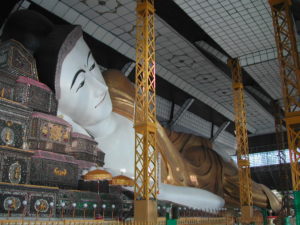The image of a Reclining Buddha that I use in my Forum Profile has great significance in Buddhism. The image is not of the Buddha sleeping, but of him lying on his death-bed just before his final passing away (parinibbāna). For most people, the last hours of a beloved parent is a moment of great sadness, and the dying person may be greatly distressed too, fearful of what might lie ahead, or grief at separation from loved ones. However, in the case of the Buddha, it was the moment of his final victory over Māra. On the eve of his Enlightenment, he gained personal realisation of the truth and liberation from suffering, but his duty was not yet complete. He had to strive and face adversity for forty-five more years in order to propagate and establish his teaching.
During his last Rains Retreat (August to October) the Buddha was visited by Māra urging him to pass away as he had already accomplished his task of establishing the monastic communities of monks and nuns, and his teaching would therefore be continued after his demise. The Buddha told Māra to wait, and declared that three months from that time he would attain the final nibbāna. This event recorded in the Mahāparinibbāna Sutta is significant, because it would put the date of the Buddha’s demise sometime in January, not in May when the Buddha’s final demise is usually commemorated in most Buddhist traditions.
In Theravāda countries, the anniversary of this great event passes by unnoticed in January. The full-moon day this year is 12th January.
The photograph in my profile is, I think, taken of the “Nine-storey Buddha” in Rangoon, which is a huge reclining Buddha not far from the Mahāsi meditation centre. There is an older and more famous statue in Pegu, called the “Shwethalyaung Piya.”

